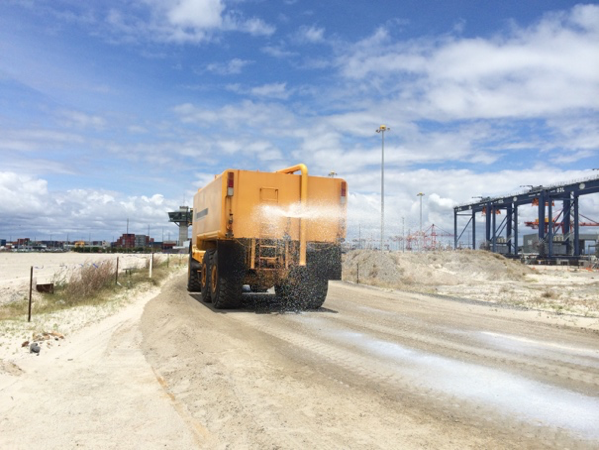
Bitumen emulsions
A bituminous emulsion is a two-phase mixture of fine bitumen droplets and emulsifiers, dispersed in water. The binding and sealing properties, robustness and re-workability of bitumen makes this a reliable dust control solution, particularly for treating and maintaining haul roads. Bitumen emulsions are specifically formulated to minimise wheel generated dust, as well as bind, seal and suppress fugitive dust.
For dust control applications, bitumen emulsions can either be sprayed onto existing road surfaces via a series of light dilutions or otherwise incorporated into the wearing course layer of haul roads and access roads which are being newly established. As soon as the diluted mixture cures, it forms a water-impermeable layer that doesn’t leach into permeable pavement materials and the underlying natural soils. Bitumen emulsions can be diluted in a water cart at a concentration of 2.5% right up to 50%, depending on the specific requirement.
There has been some debate in the industry as to whether there are any environmental risks associated with using bitumen emulsions, due to the fact that bitumen is an oil based product. However, since bitumen emulsions are largely water based, and often highly diluted, they have minimal impact on the environment. Also, once the water-impermeable layer is formed, there is no risk to surrounding vegetation or the underlying soil.
Particular care does need to be taken when there is a likelihood of rain falling before the emulsion breaks and the bitumen layer agglomerates and cures. So for this reason, specially trained experts should always be used to apply, monitor and reapply bitumen emulsions.
Learn more about Dust-A-Side Australia’s proprietary bitumen emulsion - DASProduct
Lignosulfonates
The overall impact on the environment from applying lignosulfonates for dust suppression purposes is almost negligible.
Emulsified lignosulfonates are by-products from sulphite paper and timber making processes in which sulfonated lignin, a polymer built up of phenyl propane subunits, is dispersed in an aqueous solution. These binding properties of lignin are enhanced by the addition of sugars which helps bind surface road particles together. Water evaporates from the lignosulfonate as it dries and the dust particles are trapped by the high-viscosity, naturally sticky material.
The manufacture of lignosulfonates involves evaporation and this evaporation process drives off any volatile contaminants such as acetic acid. As a result, lignosulfonate based products have very low toxicity towards plants, low order of toxicity towards fish and present no risk of contaminating groundwater. In fact, lignin is natural enough to be used as a binder product in animal feed, depending on the type of white liquor / aqueous used during the cooking phase.
The non-hazardous features and abundant supply of lignosulfonate based suppression sprays make for an excellent dust control solution on roads.
Learn more about Dust-A-Side Australia’s lignosulfonate based product - HydroTac
Surfactants
Surfactants (or wetting agents) are formulated to reduce the surface tension of water when used for dust suppression.
Ratio feeding surfactants to water sprays in dust suppression systems for material processing and transfer points, softens the water by enhancing the attraction of treated water molecules to the dust particles and increases the water droplets’ performance. Dust particles are therefore less susceptible to becoming and remaining airborne. The most effective surfactants increase the ability to suppress overall dust levels by 85%+ when compared with plain water.
Many surfactants available today are environmentally friendly and some are even biodegradable. Formulations are based on organic surfactants rather than synthetic polymers. They are often solvent-free, non-corrosive and water based.
Studies have shown surfactants to be non-toxic to humans, animals, marine life and plants. Therefore, modern surfactants are definitely safe for the environment and can be used in mining operations, construction sites, landfills and on unpaved roads. The additional benefit they offer to the environment is they help cut water usage significantly by improving the effectiveness of the water that is used.
Learn more about Dust-A-Side Australia’s surfactant based product - HydroWet
Looking for environmentally-friendly dust control solutions? Talk to Dust-A-Side Australia
We take our commitment to sustainability seriously, and as a result we have developed many products which are safe to both humans and nature.
To learn more about our cutting edge dust control solutions, call us on 1800 662 387. Or you can get in touch by clicking here.




